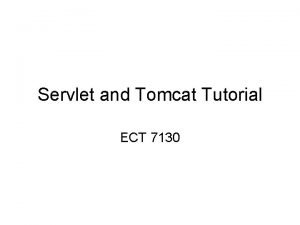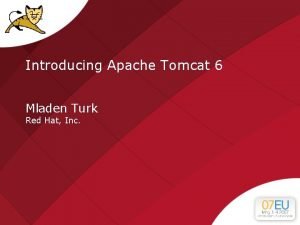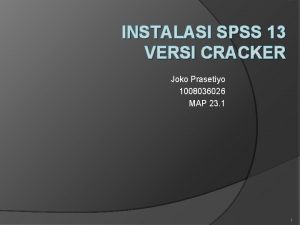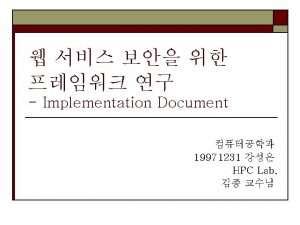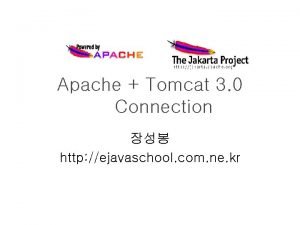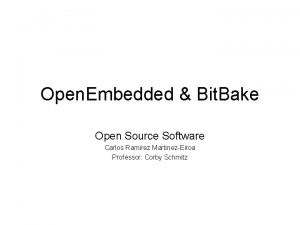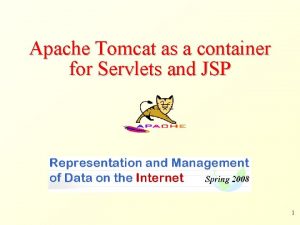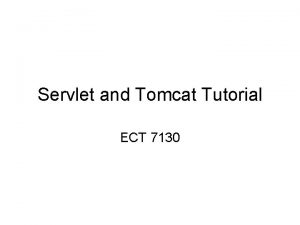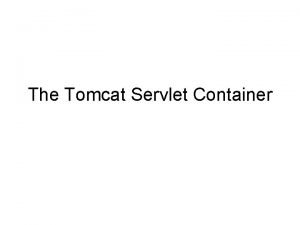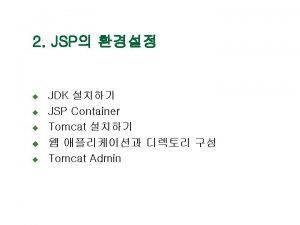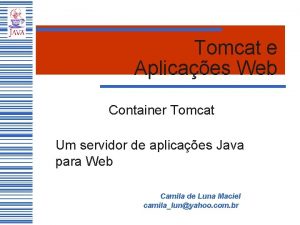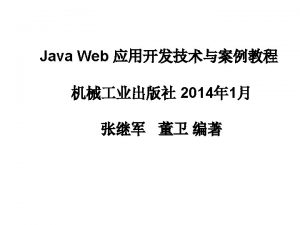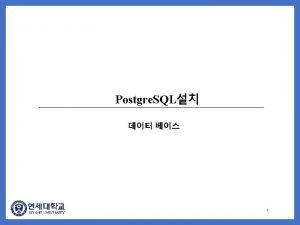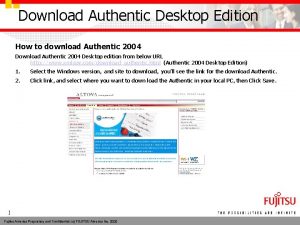Tomcat 5 5 Download current version of Tomcat























- Slides: 23

Tomcat 5. 5 • Download current version of Tomcat from: http: //jakarta. apache. or g/tomcat/ • Install it in: • C: Program FilesApache Software FoundationTomcat 5. 5 • Test it: • http: //localhost: 8080/ • Directory structure bin common ROOT 1 webapps lib … …

An simple JSP example: test. jsp <html> <%java. util. Date date=new java. util. Date(); %> <head> A Test of JSP </head> <body> <p><b> Welcome! Today is: </b></p> <%=date. get. Year()+1900%>. <%=date. get. Month()+1%>. <%=date. get. Date()%> </body> </html> 2

An simple JSP example (con’t) Edit it using an editor, e. g. Word. Pad. Save it in: C: Program FilesApache Software FoundationTomcat 5. 5webappsROOTtest. jsp Start Tomcat: C: Program FilesApache Software FoundationTomcat 5. 5bintomcat 5 Open a Web browser and go to: http: //localhost: 8080/test. jsp 3

Running JSP Page Request no JSP Servlet Current? • JSP compilation process: parse, compile, load and execute Parse JSP and Create Java Source File yes JSP Servlet in Memory? no yes Load the JSP servlet Execute the JSP servlet 4 JSP Page Response Compile Java Source File

Figure 14 -6: General. Table. jsp <!DOCTYPE HTML PUBLIC "-//W 3 C//DTD HTML 4. 0 Transitional//EN"> <%@ page import="java. sql. *" %> <HTML> <HEAD> <TITLE> Table Display Using JDBC and My. SQL</TITLE> <META NAME="author" CONTENT="Oscar LIN"> <META NAME="Keywords" CONTENT="JSP, JDBC, Database Access. "> <META NAME="description" CONTENT="an example of displaying a table using JSP. "> <LINK REL=STYLESHEET HREF="JSP-Style. css" TYPE="text/css"> </HEAD> <BODY> <H 2> Database Access Example</H 2> <%String var. Table. Name= request. get. Parameter("Table"); var. Table. Name = var. Table. Name. to. Upper. Case(); %> <H 3> Showing Data from My. SQL Database db 1</H 3> 5

<% try { // Load JDBC driver Class. for. Name("sun. jdbc. odbc. Jdbc. Odbc. Driver"). new. Instance(); String conn. String="jdbc: odbc: test"; System. out. println("Trying connection with "+conn. String); Connection conn = Driver. Manager. get. Connection(conn. String); Statement stmt = conn. create. Statement(); String var. SQL = "SELECT * FROM " + var. Table. Name; Result. Set rs = stmt. execute. Query(var. SQL); Result. Set. Meta. Data rs. Meta = rs. get. Meta. Data(); %> <TABLE BORDER=1 BGCOLOR=#ffffff CELLSPACE=5><FONT FACE="Arial" COLOR=#000000> <CAPTION><B> <%=var. Table. Name%> </B></CAPTION></FONT> <THEAD> 6

<TR> <% String var. Col. Names = ""; int var. Col. Count = rs. Meta. get. Column. Count(); for (int col =1; col <= var. Col. Count; col++) { %> <TH BGCOLOR=#c 0 c 0 c 0 BORDERCOLOR=#000000 ><FONT SIZE=2 FACE="Arial" COLOR=#000000> <%=rs. Meta. get. Column. Name(col) %> </FONT> </TH> <% }%> </TR> </THEAD> <TBODY> <% while (rs. next()) { %> <TR VALIGN=TOP> <% for (int col=1; col<=var. Col. Count; col++) { %> <TD BORDERCOLOR=#c 0 c 0 c 0 ><FONT SIZE=2 FACE="Arial" COLOR=#000000 > <%=rs. get. String(col) %> <BR> </FONT> </TD> <% } } 7

//clean up rs. close(); stmt. close(); conn. close(); } catch (Class. Not. Found. Exception e) { out. println("Driver Exception " + e); } %> </TR> </TBODY> <TFOOT></TFOOT> </TABLE> </BODY> </HTML> Example: Run it! 8

Java Bean Model 1. 9

JSP invoking Java Classes (Java Beans) • Important and Useful: – It separates the tasks of writing program logic from generating HTML; – It Reduces the complexity of managing a Web site. • Java Bean – A properly mannered Java class; – A Java class that has three properties: • there are no public instance variables; • All persistent values xxx are accessed using methods named getxxx and setxxx • Bean classes must either have no constructors or it must have one explicitly defined zeroargument constructor 10

An example using Java Bean Save it into: C: Program FilesApache Software FoundationTomcat 5. 5webappsROOTWEB-INFclasses Compile it: >javac Customer. Insert. Bean. java We get Customer. Insert. Bean. class Edit New. Customer. html Save it into: C: Program FilesApache Software FoundationTomcat 5. 5webappsROOT Edit Customer. Insert. Using. Bean. jsp Save it into C: Program FilesApache Software FoundationTomcat 5. 5webappsROOT Start Tomcat C: Program FilesApache Software FoundationTomcat 5. 5bintomcat 5 11

An Example using Java Bean and JDBC JSP: Display the result set retrieved from Table Testinfo in the database db 1 Use the Java Bean DBUtil_My. SQL. class Java: Load the JDBC driver Set up the connection Get the Result. Set 12

An example using Java Bean and My. SQL // A Java Bean source code: DBUtil_My. SQL. java package lin; import java. io. *; import java. sql. *; It is necessary to use a package, Otherwise something will go wrong. public class DBUtil_My. SQL { // For My. SQL String s. DBDriver="com. mysql. jdbc. Driver"; String s. Conn. Str="jdbc: mysql: //localhost: 3307/"+"db 1"+"? user=root"; // for MS ACCESS //String s. DBDriver="sun. jdbc. odbc. Jdbc. Odbc. Driver"; //String s. Conn. Str="jdbc: odbc: test"; Connection conn = null; Result. Set rs = null; public DBUtil_My. SQL() { try { //java. sql. Driver. Manager. register. Driver(); Class. for. Name(s. DBDriver); } catch(java. lang. Class. Not. Found. Exception e) { System. err. println("test. JDBC(): " + e. get. Message()); 13 } }

An example using Java Bean and My. SQL public Result. Set execute. Query(String test. JDBC) { rs = null; try { conn=Driver. Manager. get. Connection(s. Conn. Str); Statement stmt = conn. create. Statement(); rs=stmt. execute. Query(test. JDBC); } catch(SQLException ex) { System. err. println("aq. execute. Query: "+ex. get. Message()); } return rs; } } Save it in: webappsROOTWEB-INFclassesDBUtil_My. SQL. java >javac –d DBUtil_My. SQL. java Copy the file we got from the compilation DBUtil_My. SQL. class in C: lin to C: Program FilesApache Software FoundationTomcat 5. 5webappsROOTWEBINFclasseslin 14

test. DB_My. SQL. jsp <html> <head> <meta http-equiv="Content-Type" content="text/html; <% charset=gb 2312"> while (rs. next()) <title> MY FAQ</title> { str_name=rs. get. String("name"); </head> str_gender = rs. get. String("gender"); <body> out. println(" name is: " + str_name); <p><b> This is my name! </b> </p> out. println(" gender is: " + <%@ page language="java" import ="java. sql. *" page. Encoding="gb 2312" str_gender); %> %> <p> </p> <% <jsp: use. Bean id='work. M' class="lin. DBUtil_My. SQL" /> } <jsp: set. Property name="work. M" property="*" /> } RS. close(); %> <% </body> Result. Set RS = work. M. execute. Query("SELECT * </html> FROM testinfo"); while (RS. next()) { Result. Set rs = work. M. execute. Query("SELECT * Save it to: FROM testinfo"); C: Program Files String str_name, str_gender; Apache Software Foundation out. println("Get data from a database: : "); Tomcat 5. 5webappsROOT %> <p> </p> Go to: 15 http: //localhost: 8080/test. DB_My. SQL. jsp

My. SQL • Downloading My. SQL – An open-source DBMS product that runs on Unix, Linux, and Windows • Provides quick and efficient query handling • Allows you to create users, databases, tables, auto incrementing fields, etc. – The My. SQL open-source driver may be downloaded from: http: //worldserver. com/mm. mysql 16

• Get and Install a Recent Version • Download the 4. 0 and/or 4. 1 versions of the My. SQL win 32 distribution. • Find the downloaded file, unzip it and start the setup program: • By referring to http: //www. analysisandsolutions. com/co de/mybasic. htm • Install it to C: Program Filesmysql 40 • Start it: C: Program Filesmysql 40bin 17

– Limitations • While My. SQL is extremely inexpensive and provides many capabilities, it is not as powerful as commercial products, such as Oracle and SQL Server – Using My SQL • My. SQL commands: use, show, describe 18

Using My. SQL • • >mysql –P 3307 –u root mysql >Show databases; >s. How databases; (OK) >Use db 1; >Show tables; >Describe testinfo; >Select * from testinfo; Or • >q • Edit sql. txt • >bin>mysql –P 3307 –u root mysql <C: wansql. txt 19

My. SQL Connector/J – The latest version of the driver is My. SQL Connector/J (formerly MM. My. SQL driver) • is a Java driver that converts JDBC calls into the network protocol used by the My. SQL database. • is a Type 4 JDBC driver and has a complete JDBC feature set that supports the capabilities of My. SQL. • Download the driver from • http: //dev. mysql. com/downloads/connector/j/3. 1. ht ml • Unzip it to get the jar file: mysql-connector-java 3. 0. 16 -ga-bin. jar • copy it to a public place: • …Tomcat 5. 5commonlibmysql-connector-java-3. 0. 16 -ga-bin. jar 20

– JDBC connections • JDBC connection to My. SQL is different from other user connections – Same machine: via socket – Different machines: via TCP/IP 21

– A work-around allows you to grant access to the database@’%’ for the specific account » The wildcard % states that the database may be accessed from any host » Alternatively, you may supply the specific IP address for your local machine –this provides better security – Concurrency control • Limited support: read/write locks – Backup and recovery • Limited support: database/table saving, log files 22

Summary • JDBC – – JDBC driver types Java Servlet and Applets JDBC architecture and components Applications of JDBC • JSP (Java Server Pages) – JSP, Servlets and Apache Tomcat • My. SQL – My. SQL and JDBC Connections; Concurrency control, and backup and recovery • Questions? 23
 Tomcat tutorial
Tomcat tutorial Mladen turk
Mladen turk Normality test
Normality test Spss 13 free download full version crack
Spss 13 free download full version crack Ve7cc user manual
Ve7cc user manual The constant current area of a fet lies between
The constant current area of a fet lies between Hazard based safety engineering
Hazard based safety engineering Ac systems lesson 4
Ac systems lesson 4 Balanced wye wye connection
Balanced wye wye connection Line current and phase current
Line current and phase current Mesh current method with current source
Mesh current method with current source Drift vs diffusion current
Drift vs diffusion current Slideplayer
Slideplayer Difference between phase voltage and line voltage
Difference between phase voltage and line voltage What is diffusion current and drift current
What is diffusion current and drift current Why must the electrode holder be correctly sized?
Why must the electrode holder be correctly sized? Drift current density unit
Drift current density unit N=nc exp(-eg/2kt)
N=nc exp(-eg/2kt) Tomcat soap
Tomcat soap Tomcat настройка
Tomcat настройка Pfister tomcat
Pfister tomcat Apache http tomcat
Apache http tomcat Bake software
Bake software Apache tomcat container
Apache tomcat container
